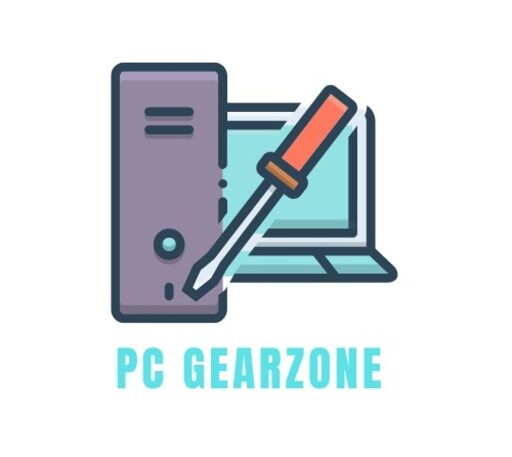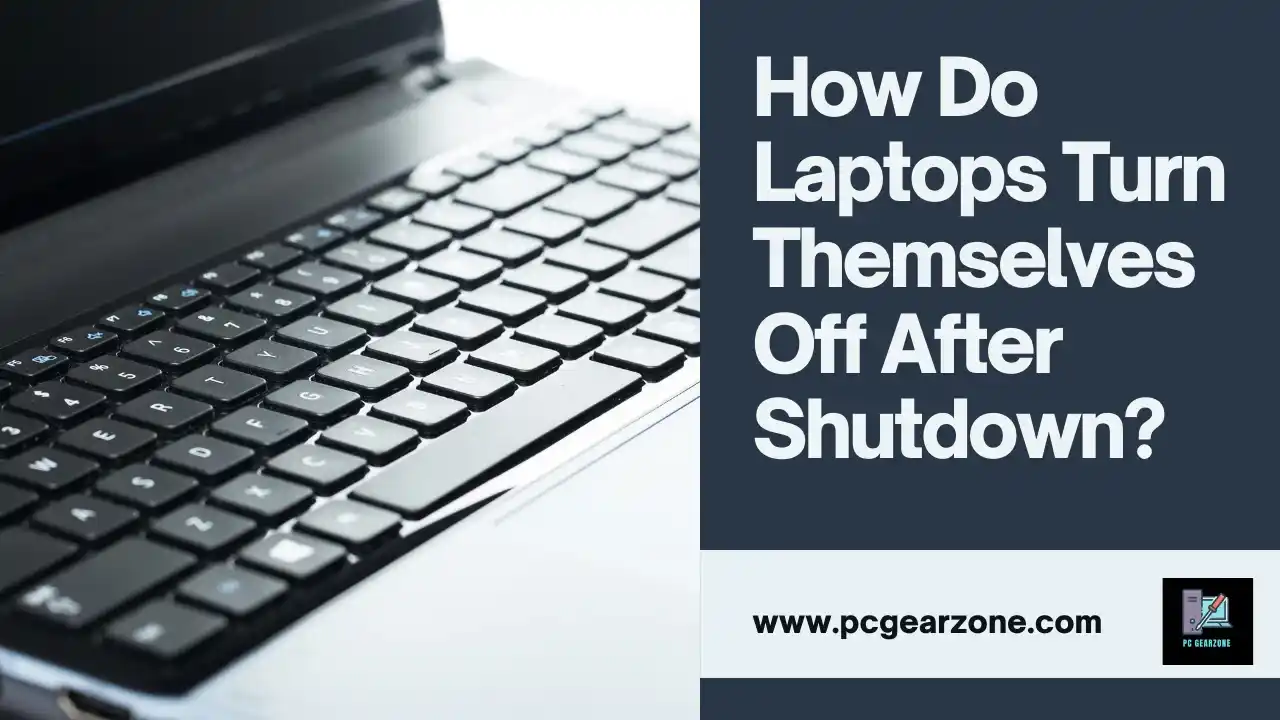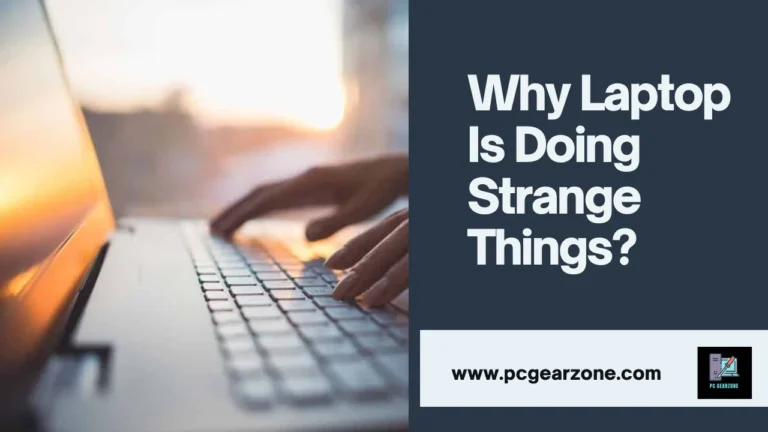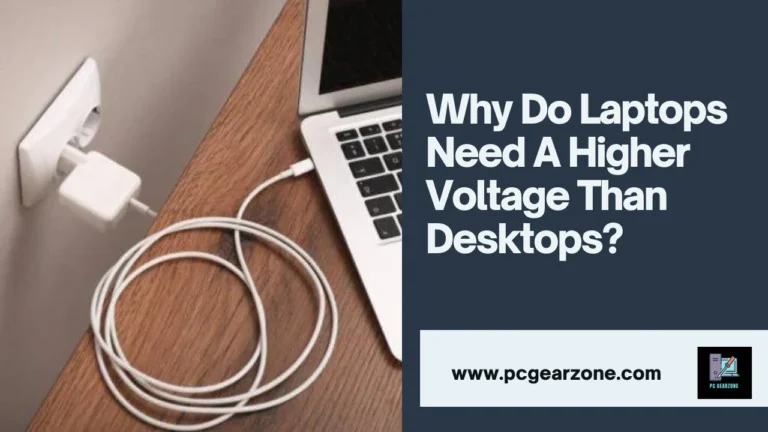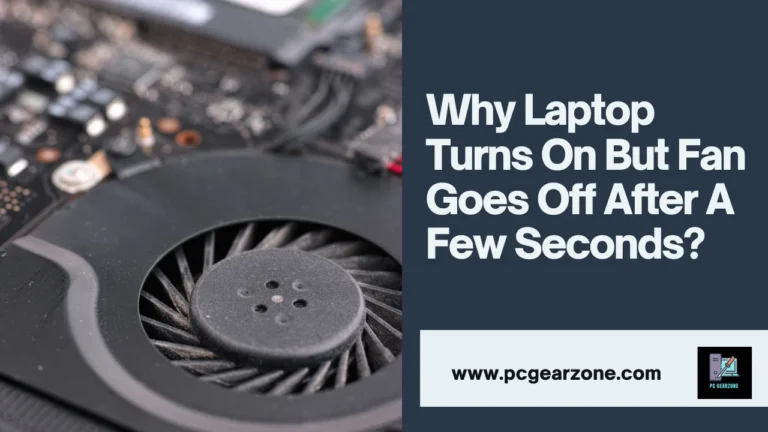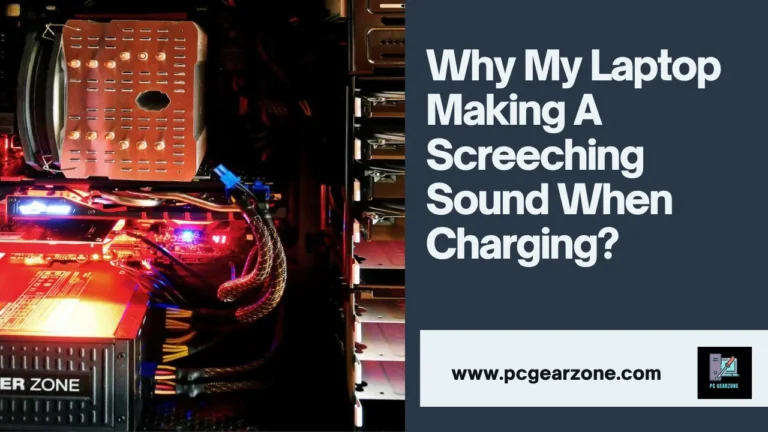How Do Laptops Turn Themselves Off After Shutdown?-Behind the Scenes of Laptop Shutdown
Reviewed by: Amir Dylan
Fact Checked by: Tom David
Last Updated on: 20 August 2024
Have you ever thought about how your laptop automatically turns off when you press shut down? This seems simple but can be difficult to understand sometimes. Your operating system and several hardware components have to work together for this process to happen. But don’t worry! In a few minutes, you will know everything about this common tech puzzle!
In this blog we will not only talk about it in theory, but also on my experience and insights from credible authorities. Furthermore, we are going to use helpful resources such as records, PDFs and website links in order for us all to get a full comprehension about this topic. So sit tight while we open up the hidden world beneath your laptop’s power button!
Short Answer: How Do Laptops Turn Themselves Off After Shutdown?
The shutting down of a laptop is an intricate process. The first step is that the OS (Operating System) takes around 1-2 seconds to close applications and save data. After this, it delivers shutdown signals to hardware, with components such as the hard drive needing three to five seconds before they can spin down.
Eventually, within a fraction of one second, the motherboard stops supplying electricity thereby making your computer enter into a sleep mode where only minimal power is consumed.
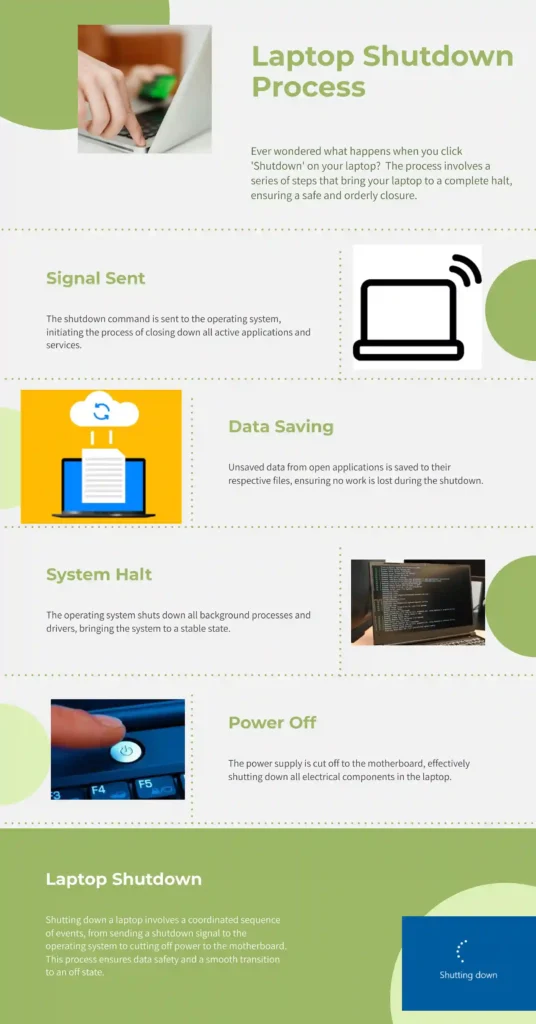
What Are The Common Causes of Laptops Turning Themselves Off?
Overheating (40%): It is usually because of a fan or vent full of dust. Dust particles can accumulate inside the computer and make the temperatures higher than they are supposed to go which triggers an automatic halt aimed at saving it from damage.
Hardware failure (25%): Power disruption or system instability that leads into unexpected shutdowns can be caused by faulty components such as bad RAM modules (10%) or malfunctioning hard drives (15%).
Software problems (20%): Outdated drivers; corrupted files in the OS; even malware programs may mess with power configurations thus making systems crash when they are least expected to.
Unintentional pressing of power button (10%): It may seem obvious but an accidental press, especially during sleep mode or when one’s laptop gets bumped around could result in shutting down mistakenly.
Low battery level warnings (5%): Most laptops alert users before going off due to low charge however some old models might just do so without any prior notice if their batteries reach critically low levels.
NOTE:
The speed at which a laptop powers down can vary based on factors like processor speed, storage type, and operating system. To compare these specs across different models, check out our:
Read it if your laptop is experiencing unexpected shutdowns.
How Do I Fix My Laptop Turning On After Shutting Down?
Here’s how to address automatic restarts after shutdown including troubleshooting steps with estimated times:
Turn off Quick Start (5 minutes): This is a feature of Windows that can cause conflicts. Go to Control Panel > Power Options > Choose what the power buttons do > Change settings that are currently unavailable > Uncheck “Turn on fast startup (recommended)” and save changes.
Look for BIOS Updates (10-15 minutes): Bugs may be present in outdated BIOS. Visit your laptop manufacturer’s website and download the latest BIOS update (follow their instructions for safe installation).
Check Power Configurations (5 minutes): Make sure that your power plan does not automatically turn on after some time of being idle. To do this, follow Control Panel > Power Options > Choose a power plan > Change plan settings then check “Turn on a timer to wake the computer” configurations.
Find Out Which Devices Are Causing Problems (10-20 minutes): Disconnect all external peripherals such as printers or USB drives then restart; if problem continues it is not peripheral but if it stops identify problematic device and try updating its drivers.
Think about Hardware Scan (30-60 minutes): Run a diagnostic tool provided by laptop manufacturer or third party tools like MemTest86 to check if RAM is faulty.
| Stage | Description | Estimated Time |
| User Action | Clicks the shutdown button | Instant |
| OS Tasks (1-2 sec) | – Closes running programs | 1-2 seconds |
| – Saves open documents and user preferences | ||
| – Prepares hardware components for shutdown | ||
| Hardware Prep (3-5 sec) | – Hard drive parks its heads (fraction of a second) | 3-5 seconds |
| – Network adapter and USB controllers prepare for power loss (2-3 seconds) | ||
| Final Power Down (<1 sec) | – OS issues final shutdown command to motherboard | <1 second |
| – Motherboard cuts power, laptop enters low-power state |
Note: While this article focuses on laptops turning themselves off after shutdown, understanding related issues can provide valuable insights. For instance, if your laptop’s fan turns off unexpectedly, it might be linked to deeper problems. Check out our article on laptop fan issues for more information.
My Personal Experience
I have come to understand from my own personal encounters that a small processor, microcontroller or circuit with low power consumption is responsible for managing the shutdown process in laptops. This element is powered by standby power from the PC’s power supply unit or battery of the laptop itself. The microcontroller unit (MCU), which can be an individual chip or integrated into chipset, stays active until there is complete disconnection of power.
Below is what happens during shutting down:
Standby Microcontroller : The MCU uses less than one watt and always remains on standby mode where it monitors power button among other crucial functions.
OS Shutdown Command: After you initiate shutdown command, OS begins its sequence by ensuring all applications/processes are closed properly which usually takes about 20-40 seconds.
BIOS ACPI Power Interface: OS sends request for shutting down to BIOS/UEFI through ACPI (Advanced Configuration and Power Interface) within milliseconds after completing tasks.
Main CPU Halt: Main CPU stops executing instructions based on received order from operating system so this step happens almost instantly.
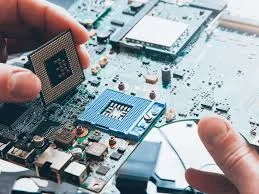
MCU Power Off Command: When MCU receives message about shutdown then it turns off main power supplies because they are low-power MCU. All these steps take approximately 1-3 seconds for safe powering down of all components.
Could Faulty Hardware Cause My Laptop to Shut Down Spontaneously?
Yes, overheating components, failing RAM, or a troubled hard drive can all trigger unexpected laptop shutdowns.
- Device Manager entry (1-2 minutes): Utilize the combination of Windows key and X then select Device Manager from the list that appears.
- Reviewing device status (2-5 minutes): Look for devices that have a exclamation point (!) or an x next to them. These symbols indicate possible problems.
- Checking device properties (3-5 minutes per device): Right click on a device with an issue and choose Properties. In the General tab, look at Device Status for error messages. The Events tab may give you some additional info about what went wrong (within the last few days/weeks).
Here are some common devices that fail, and how they appear in Device Manager:
- Storage Controllers (Hard Drive Issues): A yellow exclamation point might imply driver problems; a red X could mean hardware failure.
- Disk Drives (SSD/HDD): Check S.M.A.R.T status in Details tab of drive properties — warns of imminent failure.
How Does the OS Ensure a Safe Shutdown?
This is how your OS safely shuts down your laptop (with time estimates):
- Clearing Applications and Data (1-2 seconds): The operating system closes out applications that are currently running, saving open documents and user settings so that minimal data is lost and programs can continue from where they left off after the computer restarts.
- Hardware Synchronization (3-5 seconds): While sending shutdown signals to different hardware parts, for example the hard drive is instructed to park its heads in fractions of a second but also it notifies the network adapter as well as USB controllers about impending power loss within 2-3 seconds.
- Final Power Off (less than 1 second): After preparing all devices for shutdown and ensuring data integrity, an OS gives a last command to the motherboard which then cuts off power within a fraction of a second thus putting laptop into sleep mode.
What Role Does the BIOS/UEFI Play in Shutdown?
I will show you how the shutdown process can occur with the BIOS/UEFI and time estimations:
OS Handover (less than 1 second): As soon as the Operating System (OS) finishes its tasks and gets ready to shut down, it hands over control to BIOS/UEFI (Basic Input/Output System or Unified Extensible Firmware Interface) in less than one second.
Power Management and Final Checks (1-2 seconds): At this point, BIOS/UEFI takes charge of power management and carries out final checks. It may involve ensuring that all hardware components have acknowledged receiving a shutdown signal from the system and are prepared for powering off which can take 1 to 2 seconds.
Power Cutoff and Hardware Initialization (less than 1 second): After receiving confirmation from the OS about successful completion of power management operations, BIOS/UEFI gives a command to motherboard to cutoff power finally. Motherboard then does this within fractions of seconds.
Does a Laptop Need to Be Regularly Shut Down?
Advantages of Frequent Shutdowns (Once or Twice a Week):
Better Performance (Maximum 5%): As time goes on, there may be an accumulation of temporary files and background processes that could affect the performance. A shutdown is needed for these to be cleared by the system so it can refresh itself thereby giving room for potential increase in performance up to 5% depending on how you use your device.
Security Updates (Not Consistent): Restarting may be required for some system updates especially major security patches to take effect. If you do not regularly shut down your laptop, then chances are that you might be postponing crucial security updates which if left undone can make your system more vulnerable (the frequency with which these take place depends on the OS and settings used).
Hardware Life Span Reduction (Negligible): The hard drive among other parts needs rest therefore switching off completely allows them relax though this has slight effect because current notebooks are built such that they withstand continuous usage without wearing out fast due to failure shut down often.
Low Power Mode: Also known as “Modern Standby”; most modern laptops come fitted with sleep modes characterized by low power consumption rate hence can wake up faster than when fully operational but still consume least amount of energy.
What Happens if You Don’t Shut Down Your Laptop for a Day?
Immediate Effects (24 Hours):
Little or No Effect (Most Likely): Most of the time, no apparent problems will show within a day of nonstop usage. Laptops are made to be used for long periods.
Potential Decrease in Performance (2% at most): Temporary files and processes running in the background could accumulate with time causing slight decrease in performance which can be up to 2% when using it more frequently before restarting it for a while.
Increased Power Consumption (2-5 watts): Running laptop consumes higher amounts of power than sleep mode does (around +2 up to +5 watts depending on hardware and usage).
Long-Term Effects (Weeks/Months):
Progressive Deterioration Of Performance: If not shut down over longer times, temporary files and general system clutter may build up more significantly resulting into noticeable slows. This greatly depends on how often you use your computer as well as number programs running simultaneously.
Hard Drive Life Span Reduction (Negligible Impact): Although current hard drives are designed with sturdiness in mind, continuous activity can still put them under minimal strain which might affect their life spans not very much since it is difficult to quantify this effect exactly .
Missed Security Updates (Different Occurrences): Some updates require rebooting so that they become active; thus if one keeps their laptop on throughout these patches could take longer to install thereby leaving machine exposed for extended periods due frequentity updating being dependent on OS type being used by an individual plus settings applied too.
Is It Bad to Leave My Laptop on All the Time?
Possible Advantages of Keeping Your Laptop On For 24 Hour:
Convenience (Subjective): According to this, the most important thing is that it should be instantaneously available. No need of waiting for boot-up times which leads to fast resumption of tasks or downloads.
Modern Standby Mode (Less Power Use): These days, many laptops have sleep modes such as “Modern Standby” which ensures quick wake-up while consuming least power i.e., 2-5 watts less than full operation.
Disadvantages of Leaving It on Continuously:
Sluggishness (Up To Five Percent Over Weeks): Temporary files and background processes could build up with time thereby resulting into slow performance over extended periods – up to five percent per month in some cases depending on usage. This can be fixed by restarting the system.
Increased Wear and Tear (Negligible): Although they are made to function continuously over long periods, continuous running may cause slight wear and tear especially on components like fan; however this effect is expected to be minimal for majority of users.
Missed Security Updates (Varying): Certain system updates need restarts in order for them become active hence if one leaves their laptop turned on such patches might not be installed immediately so it will stay unprotected against potential threats longer than necessary (frequency varies across different OSes and configurations used).
Article You Might Be Interested: Vaio Laptop Takes Too Long To Post
Are There Different Ways My Laptop Can Turn Off?
Full Shutdown (Minimum Power Consumption):
Process: This is the traditional way of “turning off” things. The operating system (OS) closes programs gently, saves data, and tells hardware to get ready for shutdown. In the end, the motherboard cuts power and sets your laptop into a low-power state.
Estimated Time: Usually, it takes about 5-10 seconds in total; OS jobs take 1-2 seconds while hardware preparation may consume 3-5 seconds.
Benefits: Provides lowest power consumption and complete system refresh. Best for when you’re not using it for a long time or want to install updates that require restart.
Sleep Mode (Medium Power Consumption):
Process: The OS puts the laptop into a low-power state but keeps system memory and open applications intact. Network connections may be suspended, and the screen turns off.
Estimated Time: Usually less than 5 seconds are required to enter sleep mode.
Benefits: Allows quick wake-up times and fast task resuming. However, this mode consumes more energy than full shutdown yet less than full operation.
Hibernation (Lowest Power Consumption during Sleep):
Process: Similar to sleep mode but with one difference – before shutting down completely, an OS saves open applications together with system data onto the hard drive so that after awakening everything could be restored even if there was a blackout.
Estimated Time: Hibernation usually takes longer than sleep mode – about 10-20 seconds depending on the amount of data being saved.
Benefits: Least power consumption during sleep; allows waking up from where you left off even after power failure. Nevertheless, compared with sleep mode, wake-ups are slower.
Hybrid Sleep (Mix of Sleep and Hibernation):
Process: Some Windows laptops provide this mode which combines features of hibernation with those of sleep. A part of system information is saved by an OS onto HDD while leaving frequently used data in memory thus enabling quicker awakening than in case of pure hibernation but still preserving some power-saving advantages offered by it.
Estimated Time: Hybrid sleep times fall between sleep and hibernation, usually taking around 5-15 seconds.
Benefits: Balances wake-up speed and power consumption.
Which Shutdown Mode to Choose:
The choice of the mode depends on your requirements. If you are going to continue working shortly, sleep mode should suffice. For longer periods of inactivity or possible blackouts, hibernation or full shutdown would be better. Consider what matters more for you – power usage, wake-up time, data retention etc., when making decisions.
Helpful Resources:
- Forum: Tomsguide forum (see this thread My laptop shuts down after being closed for a while?)
- Website: Minitools.com (They mention the Top 5 Solutions to Computer Turns on by Itself Windows 10)
Conclusion:
When you click on sleep, that is when the shutdown process starts but it’s not just a simple one step thing. The operating system works hand in hand with different hardware parts to make this happen. It shuts down applications in an orderly manner, saves files and readies the hardware for sleep. At the same time, the hard drive parks its heads while network adapters prepare themselves for power loss too. Eventually however, control gets passed over from OS to BIOS/UEFI which then shuts down PC completely by issuing final command through motherboard thus cutting off all power supply and putting laptop into standby mode within seconds.
Frequently Asked Questions:
1. What happens when I click the shutdown button?
While it seems instantaneous, clicking the shutdown button initiates a coordinated effort by your operating system (OS). The OS gracefully closes running programs, saves open documents, and prepares hardware components for a smooth power down.
2. What does the hardware do during shutdown?
Hardware components receive signals from the OS to prepare for power loss. The hard drive parks its heads to prevent data damage, and network adapters and USB controllers wind down their operations.
3. How does the laptop actually turn off?
Once the OS and hardware are ready, it sends a final shutdown command to the motherboard. The motherboard then cuts power, putting your laptop into a low-power state.
4. How long does the entire shutdown process take?
The entire shutdown process typically takes around 5-10 seconds. The OS tasks might take 1-2 seconds, while hardware preparation can take 3-5 seconds.
5. Is it bad to leave my laptop on all the time?
There’s no simple answer. Leaving your laptop on offers convenience and quick access, but it can lead to a slight performance decline over time and missed security updates. Regularly shutting down (once or twice a week) is recommended for optimal performance and security.
6. How long does it typically take for a laptop to fully shut down?
The time it takes for a laptop to fully shut down varies depending on several factors, including the laptop’s hardware, the operating system, the number of running applications, and the size and number of files being saved. Generally, it should take anywhere from 10 to 30 seconds.
7. What components are primarily involved in the laptop shutdown process?
The primary components involved in the laptop shutdown process are the operating system, the CPU, the RAM, the hard drive or SSD, and the power management circuitry. The operating system coordinates the shutdown process, sending signals to other components to save data, close applications, and power down.
8. Is there a difference between hibernating and shutting down a laptop?
Yes, there is a significant difference between hibernating and shutting down a laptop. When you hibernate your laptop, the system saves its current state to the hard drive and then powers down. This allows the laptop to resume quickly from where it left off without going through the entire boot-up process. When you shut down your laptop, all open programs are closed, and the system is powered off completely.
Q: Does my laptop completely power off when I shut it down?
A: Yes, when you properly shut down your laptop, it enters a complete power-off state. All components, including the CPU, RAM, and storage, cease operation.
Q: Can I safely unplug my laptop immediately after shutting it down?
A: It’s generally safe to unplug your laptop immediately after shutting it down. However, for optimal component lifespan, it’s recommended to allow a few seconds for the system to fully power off before unplugging.
My laptop turns off completely after shutting down, but it won’t turn back on.
This might indicate a battery, power adapter, or motherboard issue. Check the power cord, battery, and inspect for any visible damage. If the problem persists, consult a technician.
My laptop turns off unexpectedly while in sleep mode. What could be causing this?
Sleep mode issues can arise from various factors including hardware conflicts, software bugs, or power management settings. Check for updates, disable unnecessary devices, and adjust sleep settings.
How can I prevent my laptop from shutting down abruptly while gaming or running demanding applications?
Ensure proper ventilation, update graphics drivers, and monitor system temperatures. Consider undervolting the CPU to reduce heat generation.
My laptop turns off after a specific period of inactivity. How can I adjust this setting?
Access power options in your operating system to modify screen timeout, sleep, and hibernation settings. Experiment with different configurations to find the optimal balance.
Why does my laptop turn off unexpectedly after going to sleep?
Sleep mode issues can arise from various factors, including hardware conflicts, software bugs, or power management settings. Check for updates, disable unnecessary devices, and adjust sleep settings.
How can I prevent my laptop from turning on automatically after a power outage?
To avoid unexpected startups after power outages, unplug unnecessary peripherals and consider using a UPS. Check your power settings to ensure the “wake on power failure” option is disabled.
My laptop’s battery drains quickly even when it’s turned off. What could be the issue?
A battery drain while the laptop is off might indicate a software issue, a hardware malfunction, or a battery problem itself. Check for background processes, update drivers, and consider battery calibration.
Can I safely unplug my laptop while it’s in sleep mode?
It’s generally recommended to avoid unplugging your laptop while it’s in sleep mode, as this can interrupt the power-saving process and potentially damage the system.
What is the difference between sleep mode and hibernate mode?
Sleep mode saves the laptop’s current state to RAM, allowing for a quick resume. Hibernate mode saves the state to the hard drive, using less power but taking longer to resume.
Can a faulty power supply cause unexpected shutdowns?
Yes, a faulty power supply can provide insufficient or unstable power, leading to unexpected shutdowns or other issues.
How can I check the health of my laptop’s battery?
Most operating systems have built-in tools to check battery health. Additionally, you can use third-party software or consult a technician for a more detailed assessment.
Can overheating cause unexpected shutdowns?
Yes, overheating can trigger safety mechanisms that shut down the laptop to prevent damage. Ensure proper ventilation and monitor system temperatures to avoid overheating.
Articles You Might Be Interested:
Why Laptop Is Doing Strange Things?
Why Do Laptops Need A Higher Voltage Than Desktops?
